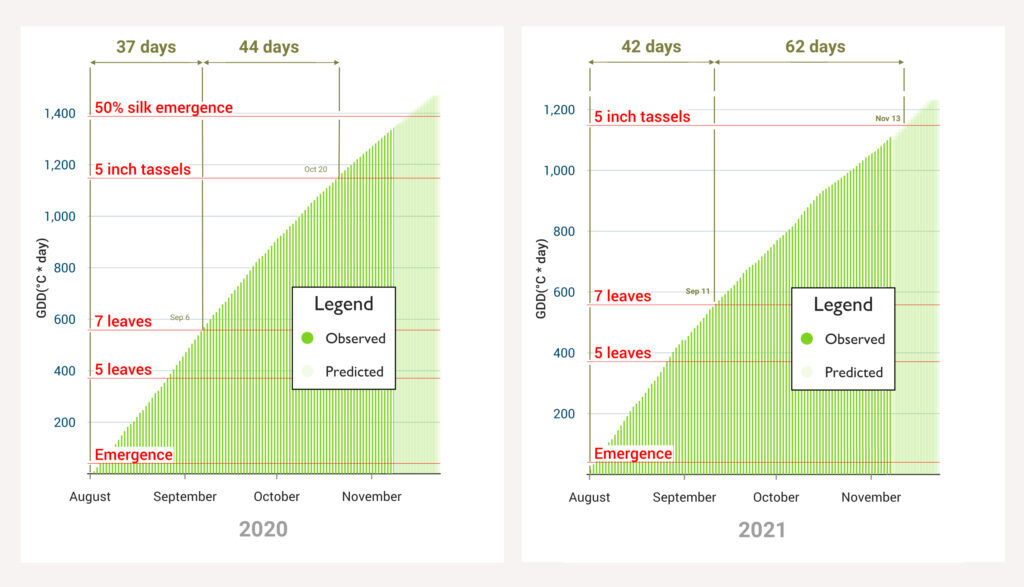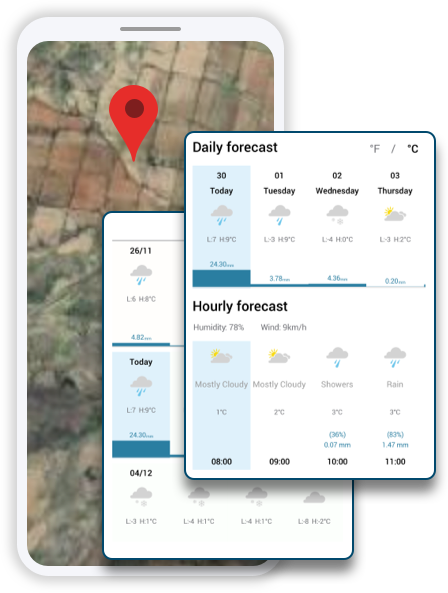Hyperlocal weather forecast for better farming
From sowing to harvest, the weather is one of the key factors for a successful yield. A hyperlocal weather forecast is an essential tool for growers who want to ensure healthy and productive crops.
Weather conditions affect crops from seed to fruit and should influence the decisions growers make in the field to maximize quality and yield. Irrigation, pest and disease management, and other aspects can be optimized if planned accordingly. Weather conditions can also dictate how and when fieldwork can be done, and it can change (or even prevent) harvesting.
In this article, we are going to discuss the important weather considerations during the growing season and describe how technological advancements allow farmers to derive weather-wise plans and stay up-to-date with hyperlocal weather forecasts like never before.
Temperature considerations for planting and harvesting
Plant development is strongly influenced by ambient temperature exposure. Generally speaking, warmer days advance the growth of plants while cooler days stunt growth. The accumulated degrees above a threshold (the base temperature) are referred to as the growing degree days (GDD). This is used to estimate the growth of certain plants during the growing season. The method is considered a more accurate estimation of the growth stage for plants compared to the age of plants. Tracking the GDD can help growers with deciding on the timing for fertilization and harvesting.
On the other hand, in some plants, winter dormancy release depends on having a sufficient number of accumulated chill hours, as in apples or grapes. If the temperature does not drop low enough, the release from dormancy and subsequent plant flowering may become weak and uneven. In the absence of optimal conditions, the grower needs to apply chemicals to “wake” the plants and induce a uniform flowering.
When sowing, several questions need to be addressed. Has there been enough water accumulation in the soil for seeds to sprout and develop? Are the days following the sowing going to have enough sunlight? Is there a danger of frost? Also, in certain crops, the temperature at the time of the harvest is important. For example, the sugar content and composition of wine grapes is more stable at lower temperatures so grapes are often harvested in cooler times of the day.
Accurate long and short-term weather forecasting is a crucial tool for growers when planting and harvesting timing needs to be planned ahead.

Weather-wise irrigation planning
Once the field is sowed, weather forecasting helps growers optimize growth conditions. Weather forecasting can help with planning efficient irrigation schedules that save water and reduce irrigation dependency. Knowledge of hot dry days can be anticipated in advance to allow effective irrigation that prevents plant stress. Other factors such as temperature, humidity, sunlight intensity, and wind are important as well, as water loss from the evaporation from plants and soil (known as evapotranspiration) is affected by these factors. The large amount of the variables that can change, and the high frequency of their change, makes planning efficient irrigation schedules complex. Keeping track of rain and evapotranspiration through the aid of technology provides an easy and practical way to develop precise irrigation plans that continuously update as weather conditions change.
Hyperlocal weather forecast for better pest and disease management
Not only do weather conditions dictate plant behavior and development, but weather conditions also strongly influence the emergence and development of pests and diseases such as the migration of insects, egg hatching, fungal spore development, sexual maturity, etc.
Combining a weather forecast with the knowledge of the evolution of specific pests or diseases brings a new level of sophistication to pest and disease management. Weather predictions and GDD are used to predict when pest emergence is likely to occur. Growers then know when to look for pests and how to optimally time the application of preventative measures and pesticides. For example, the adult moths of the European Corn Borer typically start to appear and mate around spring, when the weather starts to get warmer. The eggs are laid on the underside of host plants, and within several days, they hatch as larvae and start feeding. By calculating the GDD, a grower can predict moth emergence and apply preventative measures when the pest is most vulnerable (and before damage has been done).
Smart weather-based planning can also prevent wasteful applications of pesticides and fertilizer. A chemical pesticide or fertilizer applied right before rain can be washed away and will have little or no effect. Pesticide applications on windy days are also situations to avoid, as the wind can have an adverse effect on the dispersal of pesticides and even cause damage in nearby fields due to the drift. Spraying should be avoided when wind speed is above 15 km/h.
Temperature should also be taken into consideration when deciding when to spray because of several factors such as the potential for droplet evaporation, risk of phytotoxicity and more. In general, spraying pesticides should be avoided if temperatures are above 30 degree Celsius.
Relative humidity in the air is another important factor that influences the evaporation of droplets. Spraying should be avoided when humidity is low.
Knowing the right days to apply pesticides and fertilizer may make a difference between a healthy field and an unhealthy one.
Hyperlocal weather forecast
Several methods for weather forecasting are used by growers. These include large, regional weather stations that are based on a great deal of information and provide granular, low-resolution information to on-premise weather stations that are more area precise, but are relatively expensive and require installation and maintenance.
Better, faster computers and finer measurement tools have made meteorological modeling precise and weather forecasting more reliable than ever before. Observations such as temperature, humidity, and wind characteristics are gathered from different sources like weather stations, weather radars, and aircrafts, which is then fed into computers to produce weather forecast simulations. The more accurate and abundant the input is, the more precise and localized the forecasts are. The increasing power of computers allows for frequent forecast refinement that result in high-resolution predictions in space and time.
Such technological advancements make it possible to provide growers with high-resolution forecasts in an affordable way, even in rural, low-income nations that do not have access to weather measurement devices or affordable local weather stations. These new methods are important because they can predict the microclimate at the level of the field, allowing growers to prepare and plan ahead.
Agrio helps you to plan ahead
Combining weather forecasts and agricultural knowledge can have powerful outcomes. Agrio makes precise, hyperlocal weather forecast easily available to all growers. Our prediction models combine weather measurements and observations from different sources. These state-of-the-art weather prediction models provide our growers an hourly hyper-local weather forecast designated specifically to their unique area anywhere in the world; the forecast is provided at a 3km resolution so it is specific to their fields.

By leveraging technological advancements, we help growers abandon cumbersome excel sheets and instead rely on our algorithms to do the tracking for them.
Agrio provides several dedicated features that allow growers to:
- Optimize spraying times for safety and efficiency
- Track GDD for pest and disease management optimization
This allows growers to plan an efficient growing season and spraying schedule, save money, and grow stronger and healthier plants. We look forward to seeing you leverage this technology for smart and effective weather interventions in your field.
In the meantime, as always, we wish you an abundant harvest.
